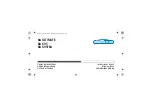
115
S:\Hp8960\E1960A GSM Mobile Test Application\A.04 Release\Reference_Manual\Chapters\prog_bursr_sync.fm
Burst Synchronization of Measurements
Burst Synchronization of Measurements
Measurement Synchronization
Measurement Synchronization Description
Measurement synchronization determines how a measurement’s time reference is determined from the
measurement data (a sampled time record). Measurement synchronization occurs after the measurement data
is captured.
For the transmit power and ORFS (switching and modulation) measurements, the RF amplitude of the input
signal is used for measurement synchronization. For Phase and Frequency Error Measurement and the Power
versus Time Measurement (see
“Phase and Frequency Error Measurement Description” on page 82
and
“Power versus Time Measurement Description” on page 88
.), however, there are three possible settings for
measurement synchronization:
• Midamble
• RF Amplitude
• None
Selecting midamble causes the test set to use the input signal’s midamble data to determine the
measurement’s time reference. A measurement is capable of midamble synchronization if the test set is able to
determine transmitted data from measurement samples (i.e. perform demodulation). Midamble
synchronization is not available for Transmit Power measurements, however Power vs. Time measurements
performs the average power measurement and does provide midamble synchronization.
NOTE
When the test set’s operating mode is “test mode” or when the cell activated state is “off”, the
burst type may need to be specified before the test set can synchronize to the input signal’s
midamble. See
.
Selecting RF amplitude causes the test set to use the input signal’s rising and falling edges (if edges are
detected within the sampled time record) to determine the measurement’s time reference. If a non-bursted
signal was sampled, the measurement’s time reference will be developed using the beginning and end of the
sampled time record, and the samples used for making the measurement will be taken from the middle of the
time record.
Selecting None causes the test set to perform measurements exactly as if RF amplitude was chosen.
An integrity indicator is returned for each completed measurement. Integrity errors are prioritized so that
when multiple errors occur, the highest priority error is returned first, as the root error. The integrity indicator
returns a number from 0 to 16, where zero = normal. The following integrity indicators reveal problems with
measurement synchronization:
Содержание 8960 Series 10
Страница 26: ...26 Contents ...
Страница 363: ...363 S Hp8960 E1960A GSM Mobile Test Application A 04 Release Reference_Manual Chapters hpib_read fm READ ...
Страница 500: ...500 S Hp8960 E1960A GSM Mobile Test Application A 04 Release Reference_Manual ch_gen_usage fm General Usage ...
Страница 574: ...574 S Hp8960 E1960A GSM Mobile Test Application A 04 Release Reference_Manual ch_error_messages fm Error Messages ...
















































